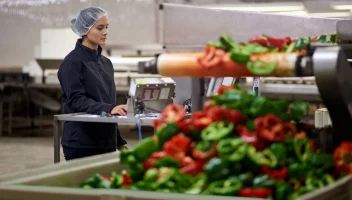In diesem Beitrag vorgestellt
Neue Perspektiven für die Obst- und Gemüsebranche: Markttrends, Herausforderungen und Technologie
Neue Perspektiven für die Obst- und Gemüsebranche: Markttrends, Herausforderungen und Technologie
11 Okt 2024
Anke Kondermann
Die Obst- und Gemüsebranche verändert sich mit jeder neuen Saison. Während neue Akteure den Markt betreten, kämpfen einige etablierte Unternehmen ums Überleben, andere wiederum florieren. Externe Einflüsse zwingen Unternehmen, sich ständig anzupassen, um wettbewerbsfähig und profitabel zu bleiben.
Auch technologisch hat sich die Branche erheblich gewandelt. Digitale Lösungen wie Enterprise Resource Planning (ERP) sind heute zentrale Bausteine, um Daten effizient zu verwalten, Ressourcen optimal zu nutzen und die Zusammenarbeit mit Handelspartnern zu verbessern. Vor allem künstliche Intelligenz (KI) revolutioniert zunehmend die Art und Weise, wie Frische-Betriebe arbeiten.
Die heutigen Herausforderungen in der Branche mögen für Erzeuger, Händler und Verarbeiter früherer Generationen teilweise vertraut erscheinen. Gleichzeitig haben sich aber entscheidende Rahmenbedingungen so verändert, dass ein Umdenken und Neulernen der aktuellen Geschäftspraktiken notwendig wäre.
Doch selbst für Branchenkenner lohnt sich ein genauer Blick auf aktuelle Entwicklungen. Wo steht die Obst- und Gemüsebranche heute, welchen Herausforderungen begegnet sie – und wie helfen KI und moderne ERP-Systeme, diesen Herausforderungen zu begegnen?
Frische Geschäftsmodelle weltweit
Die Struktur der Obst- und Gemüsebranche variiert regional stark und spiegelt typischerweise die lokale Agrarlandschaft, die Verbrauchernachfrage und die Infrastruktur der Lieferkette wider.
Anbau & Produktion
Nordamerika Die Bandbreite reicht von großen Agrarbetrieben bis hin zu kleinen, familiengeführten Höfen. In Kalifornien dominieren großflächige Farmen, insbesondere bei Sonderkulturen wie Mandeln, Trauben oder Blattgemüse. Florida ist bekannt für seine Zitrusfrüchte. Parallel dazu entstehen in Metropolen wie New York oder Chicago zunehmend urbane und vertikale Farmen, die auf lokale, nachhaltige Versorgung setzen.
Europa In Europa reicht das Spektrum von kleinstrukturierten Familienbetrieben – oft organisiert in Genossenschaften – bis hin zu professionellen Agrarunternehmen. Spanien, Italien und die Niederlande zählen zu den wichtigsten Produktionsstandorten. Letztere gelten zudem als Vorreiter im High-Tech-Gewächshausanbau.
Neue Modelle Urban Farming und kontrollierte Umgebungslandwirtschaft (Controlled Environment Agriculture, CEA) gewinnen weltweit an Bedeutung – insbesondere in Ballungszentren, in denen verfügbare Flächen begrenzt sind und die Nachfrage nach lokal erzeugten Produkten steigt.
Verpackungs- und Logistikbetriebe
Nordamerika In vielen Regionen sind Verpackung und Logistik eng mit der Erzeugung verzahnt – etwa in Kalifornien oder Florida, wo große Agrarbetriebe auch die nachgelagerten Prozesse übernehmen. Parallel dazu gibt es spezialisierte Dienstleister, die mehreren kleineren Höfen zur Verfügung stehen – vor allem im mittleren Westen der USA.
Europa Auch in Europa zeigt sich ein gemischtes Bild: Einige Unternehmen vereinen Erzeugung und Verpackung unter einem Dach, andere setzen auf externe Partner. Der Trend zu nachhaltigeren Verpackungslösungen – etwa recycelbare oder biologisch abbaubare Materialien – ist in vielen Ländern ein Treiber für Innovation.
Neue Modelle Immer mehr Unternehmen entscheiden sich dafür, Verpackung und Versand auszulagern – etwa an Co-Packing- oder Co-Shipping-Anbieter. Diese übernehmen definierte Aufgaben entlang der Lieferkette, während sich Erzeuger ganz auf ihre Kernprozesse konzentrieren können. Das erhöht die Flexibilität und entlastet insbesondere kleinere Betriebe bei Investitionen in Infrastruktur.
Distribution & Handel Distributoren
Distributoren
Nordamerika Die Landschaft reicht von großen landesweiten Anbietern wie Sysco oder US Foods bis hin zu regionalen und lokalen Verteilern. Der Direktvertrieb an Endverbraucher (Direct-to-Consumer, D2C) gewinnt an Bedeutung – auch dank digitaler Modelle wie Abos für „unperfekte“ Lebensmittel, etwa bei Imperfect Foods oder Misfits Market.
Europa Hier dominieren in vielen Märkten zentrale Distributionsstrukturen – insbesondere in Westeuropa mit seiner ausgereiften Logistik. In südlichen Ländern hingegen sind regionale Händler oft näher an Erzeugern und Endkunden, was kürzere Lieferketten begünstigt.
Neue Modelle Farm-to-Table-Ansätze und D2C-Konzepte gewinnen in urbanen Regionen an Relevanz. Der Wunsch nach Transparenz und Rückverfolgbarkeit treibt diese Entwicklung genauso wie die wachsende Bedeutung von Online-Lebensmittellieferungen.
Handelsunternehmen
Nordamerika Viele Handelsunternehmen spezialisieren sich auf den Import von saisonalen oder exotischen Produkten, um eine ganzjährige Verfügbarkeit zu sichern – eine wichtige Rolle angesichts der hohen Verbrauchervielfalt.
Europa Der Handel profitiert von der starken internationalen Vernetzung. So ist der Hafen von Rotterdam ein zentraler Knotenpunkt für den Import von Obst und Gemüse – insbesondere aus Übersee. Handelsunternehmen tragen entscheidend dazu bei, Angebot und Nachfrage auszugleichen.
Neue Modelle Nachhaltigkeit rückt zunehmend in den Fokus. Fair-Trade- oder Bio-zertifizierte Waren gewinnen an Marktanteil – auch, weil Handelsunternehmen ihr Portfolio stärker auf ethisch orientierte Verbraucherbedürfnisse ausrichten.
Dienstleister (Co-Packing, Logistik, u.a.)
Nordamerika Die Auslagerung von Verpackung, Logistik und anderen nicht-kernkompetenten Prozessen nimmt zu. Co-Packer und spezialisierte Logistikunternehmen ermöglichen es, ohne eigene Investitionen in Infrastruktur zu skalieren und gleichzeitig flexibel zu bleiben.
Europa Ähnlich wie in Nordamerika lagern viele Unternehmen Arbeitsschritte gezielt aus – insbesondere in stark regulierten Märkten. Hier können spezialisierte Dienstleister helfen, komplexe Anforderungen effizient und rechtskonform umzusetzen.
Neue Modelle Neue Anbieter bringen digitale Technologien ins Spiel – etwa zur Rückverfolgbarkeit mittels Blockchain. Sie erhöhen die Transparenz entlang der Lieferkette und bieten so zusätzlichen Mehrwert für alle Beteiligten.
Zentrale Herausforderungen für Unternehmen in der Frische-Branche
Unternehmen aus der O+G-Welt stehen heute unter hohem Druck: Einerseits steigen regulatorische Anforderungen und Erwartungen seitens der Verbraucher, andererseits gilt es, wirtschaftlich effizient zu arbeiten – oft unter schwierigen Rahmenbedingungen. Je nach Region und Geschäftsmodell zeigen sich dabei unterschiedliche Schwerpunkte. Die wichtigsten Herausforderungen im Überblick:
Nachhaltigkeit und Regulierung
Europa Die Anforderungen der EU im Bereich Nachhaltigkeit und Verpackung gehören zu den strengsten weltweit. Unternehmen müssen ihre Lieferketten transparent gestalten, umweltfreundliche Verpackungen einsetzen und komplexe Regularien wie die EU-Verordnung 2023/1115 zu entwaldungsfreien Produkten oder die neue Verpackungsverordnung einhalten. Das führt zu spürbaren Mehrkosten – insbesondere kleinere Betriebe stoßen hier oft an ihre Grenzen.
Nordamerika Zwar ist der regulatorische Rahmen in Nordamerika insgesamt weniger strikt, doch auch hier steigt der Druck – nicht zuletzt durch das veränderte Konsumverhalten. Immer mehr Verbraucher legen Wert auf nachhaltige, biologisch erzeugte und regional verfügbare Produkte. Unternehmen müssen reagieren, auch wenn sie gesetzlich (noch) nicht dazu verpflichtet sind.
Rückverfolgbarkeit und Zertifizierungen
Global Die Nachfrage nach vollständiger Transparenz entlang der Lieferkette nimmt weltweit zu. Sowohl Handel als auch Endverbraucher möchten wissen, woher die Produkte stammen und unter welchen Bedingungen sie erzeugt wurden. Zertifizierungen wie GLOBALG.A.P. gewinnen an Bedeutung – ebenso wie Investitionen in digitale Rückverfolgbarkeitssysteme.
Regionale Unterschiede In Ländern wie Deutschland, wo Lebensmittelsicherheit auch regulatorisch stark im Fokus steht, ist lückenlose Rückverfolgbarkeit besonders wichtig. Rückrufaktionen können hier ohne digitale Systeme schwer beherrschbar sein. In weniger regulierten Märkten ist der Druck zwar geringer – allerdings drohen Wettbewerbsnachteile im internationalen Handel, wenn Zertifizierungen fehlen.
Arbeitskräftemangel und Fachpersonal
Europa und Nordamerika Der Mangel an Arbeitskräften betrifft beide Regionen – insbesondere im saisonalen Bereich. Steigende Löhne, ein zunehmender Fachkräftemangel und die oft körperlich anspruchsvolle Arbeit erschweren die Besetzung vieler Positionen. Automatisierung kann hier helfen, erfordert aber Investitionen und Know-how.
Entwicklungsregionen Zwar ist der Arbeitskräftemangel dort häufig weniger ausgeprägt, doch Berichte über schlechte Arbeitsbedingungen wirken sich negativ auf die internationale Wettbewerbsfähigkeit aus – insbesondere gegenüber Märkten, in denen ethische Produktionsstandards stark beachtet werden.
Lieferkettenstörungen
Global Extreme Wetterereignisse, geopolitische Unsicherheiten oder logistische Engpässe – die Frische-Branche ist besonders anfällig für Störungen in der Lieferkette. Unternehmen müssen entsprechend vorsorgen, etwa durch alternative Bezugsquellen oder eine höhere Lagertransparenz.
Regionale Beispiele In Europa sorgen Handelsbarrieren infolge des Brexits weiterhin für Einschränkungen im grenzüberschreitenden Warenverkehr. In den USA beeinflussen klimabedingte Ereignisse wie Dürren oder Hurrikans zunehmend die landwirtschaftliche Produktion.
Anwendungen von KI in der Obst- und Gemüsebranche
Der Einsatz von KI nimmt auch in der Frische-Wirtschaft spürbar zu – von der Erzeugung über die Verarbeitung bis hin zum Endkunden. Die Technologie hilft, Prozesse zu automatisieren, Entscheidungen datenbasiert zu treffen und neue Effizienzpotenziale zu erschließen. Im Folgenden zeigen wir zentrale Anwendungsfelder auf – jeweils mit aktuellem Stand und Blick in die Zukunft.
Präzisionslandwirtschaft
Aktuell KI-basierte Systeme analysieren Sensordaten, Satellitenbilder und Wetterprognosen, um optimale Zeitpunkte für Aussaat, Düngung und Bewässerung zu ermitteln. Auch Drohnen kommen zum Einsatz: Sie erkennen Krankheiten und Schädlingsbefall frühzeitig und ermöglichen eine gezielte Behandlung – ressourcenschonend und punktgenau.
Ausblick Künftig könnten ganze Betriebe autonom arbeiten – von der Aussaat bis zur Ernte. KI-Modelle werden zunehmend vorausschauend agieren und sich selbstständig an wechselnde Bedingungen anpassen.
Optimierung der Lieferkette
Aktuell Algorithmen prognostizieren Nachfrageverläufe, optimieren Routen und helfen, Temperatur und Feuchtigkeit während des Transports konstant zu überwachen. So bleibt die Ware frisch, Ausschuss wird reduziert – und gleichzeitig steigt die Liefertreue.
Ausblick Mit wachsender Datenbasis wird KI Lieferketten noch stärker vernetzen. Die Systeme reagieren in Echtzeit auf Störungen, schlagen Alternativen vor und helfen, Kosten wie auch Lebensmittelverluste zu minimieren.
Qualitätskontrolle und Sortierung
Aktuell KI-gesteuerte Kamerasysteme bewerten Obst und Gemüse nach Größe, Form und Farbe – objektiv, schnell und zuverlässig. Die Ergebnisse übertreffen die menschliche Sortierung nicht nur an Geschwindigkeit, sondern auch an Genauigkeit.
Ausblick Künftig werden noch feinere Qualitätsunterschiede automatisch erkannt. Gleichzeitig wird es möglich, Ware mit leichten Mängeln gezielt weiterzuverarbeiten – etwa als Zutat – statt sie zu entsorgen.
Nachfrageprognose und Preisgestaltung
Aktuell Durch die Auswertung historischer Verkaufsdaten, saisonaler Trends und externer Einflussfaktoren wie Wetter oder Feiertage unterstützt KI die Absatzplanung. Unternehmen können ihre Produktion besser steuern – und ihre Preisstrategien frühzeitig anpassen.
Ausblick In Zukunft wird dynamische Preisgestaltung auf Basis von Echtzeitdaten zur Norm: KI passt Preise automatisch an Nachfrage, Verfügbarkeit und Haltbarkeit an – zum Vorteil für Margen und Nachhaltigkeit.
Kundenerlebnis und Einzelhandel
Aktuell Empfehlungsalgorithmen analysieren Kaufverhalten und Vorlieben, um personalisierte Vorschläge zu unterbreiten. Auch digitale Assistenten oder KI-gesteuerte Informationssysteme helfen, das richtige Produkt auszuwählen und Hintergründe wie Herkunft oder Nährwert transparent zu machen.
Ausblick Die Personalisierung wird weiter zunehmen – etwa in Form individualisierter Aboboxen oder KI-gestützter Menüvorschläge basierend auf Diätpräferenzen oder Allergien.
Automatisierung
Aktuell KI-gesteuerte Roboter übernehmen bereits heute Aufgaben wie Ernte, Sortierung oder Verpackung. Auch administrative Prozesse – etwa Auftragsabwicklung oder Bestandszuordnung – werden zunehmend automatisiert.
Ausblick In vielen Regionen ist damit zu rechnen, dass KI in Zukunft den gesamten Prozess von Anbau über Ernte bis zur Auslieferung begleitet – voll automatisiert und effizient, insbesondere dort, wo Fachkräfte fehlen.
Wie Aptean Fresh Produce ERP Ihr Unternehmen unterstützt
Innovative Technologien wie Präzisionslandwirtschaft, Blockchain oder robotergestützte Erntesysteme bieten enorme Potenziale – doch um diese wirksam zu nutzen, braucht es eine stabile digitale Grundlage. Genau hier setzt Aptean Fresh Produce ERP an: mit einer speziell für die Frischwarenwirtschaft entwickelten Lösung, die Transparenz schafft, Prozesse vereinfacht und Spielräume für Wachstum eröffnet.
Unsere Lösung basiert auf Microsoft Dynamics 365 Business Central – erweitert um branchenspezifische Funktionen, die auf die Besonderheiten der Obst- und Gemüsewirtschaft zugeschnitten sind. Damit profitieren Sie von einer Plattform, die Ihre täglichen Abläufe ebenso abbildet wie strategische Fragestellungen entlang der gesamten Lieferkette.
Spezialisierte Anwendungen für den Bereich Obst- und Gemüse
Advanced Attribute App Ermöglicht die präzise Verwaltung von Artikelmerkmalen – für eine differenzierte Qualitätskontrolle, dynamische Preisgestaltung und gezielte Berichterstattung. Auch die Rohwarenplanung für kommende Erntesaisons lässt sich auf Basis der Attributdaten deutlich verbessern.
Commodity Harvesting App Unterstützt die detaillierte Planung Ihrer Ernte – auf Feld-, Gewächshaus- oder Farmebene, saisonal bis hin zur täglichen Steuerung. Damit haben Sie Ihre Ressourcen jederzeit im Blick.
Weighbridge App Integriert Ihre Fahrzeugwaage direkt ins ERP-System – zur automatisierten Erfassung eingehender Liefermengen und zur Optimierung Ihres Wareneingangsprozesses.
Production Apps Mit der Families App standardisieren Sie Ihre Produktionsprozesse für mehr Effizienz und Transparenz. Die Production Cost Apportionment App ermöglicht eine exakte Kostenverteilung, insbesondere bei komplexen Grade-Out-Szenarien – so optimieren Sie Ihre Preisstrategie gezielt nach Wirtschaftlichkeit.
Sales & Trading Apps Die Profiles- und Trading Board App helfen Ihnen, Kundenanforderungen mit Produktverfügbarkeiten intelligent abzugleichen – für eine hohe Trefferquote und zufriedene Abnehmer. Die Producer Certification App stellt sicher, dass alle Zertifikate lückenlos gepflegt und korrekt zugeordnet sind – vom Auftrag bis zur Auslieferung.
Grower Return App Berechnet präzise die Vergütung für Kontoverkäufe, Pooling oder Pack-Out-Prozesse – transparent und nachvollziehbar für alle Beteiligten. Ein wichtiger Hebel zur Steigerung der Rentabilität.
Mit Aptean nachhaltig wachsen
Die Anforderungen in der Frischelogistik und Verarbeitung sind komplex – von der präzisen Steuerung operativer Abläufe über die Einhaltung gesetzlicher Vorgaben bis hin zur flexiblen Reaktion auf Marktveränderungen. Um diesen Herausforderungen strukturiert zu begegnen, braucht es nicht nur Branchenkenntnis, sondern auch die passenden digitalen Werkzeuge.
Aptean Fresh Produce ERP wurde speziell für Unternehmen entwickelt, die mit frischen Lebensmitteln arbeiten – ob im Anbau, in der Verarbeitung oder im Handel. Die Lösung basiert auf Microsoft Dynamics 365 Business Central und ergänzt die Standardfunktionen um zahlreiche branchenspezifische Erweiterungen: etwa zur Ernteplanung, Rückverfolgbarkeit, Qualitätskontrolle oder Kostenverteilung in der Produktion. Durch integrierte KI-Funktionen lassen sich viele Prozesse zusätzlich automatisieren und datengestützt optimieren.
Neben der Software selbst legen wir besonderen Wert auf eine fachlich fundierte Einführung und langfristige Zusammenarbeit. Unsere Kunden profitieren dabei von unserem Branchenfokus, praxiserprobten Implementierungsmethoden und kontinuierlicher Betreuung im laufenden Betrieb.
Wenn Sie prüfen möchten, inwiefern unsere Lösungen zu Ihren Anforderungen passen, kontaktieren Sie uns für eine persönliche Beratung oder fordern Sie jetzt Ihre individuelle Demo oder Preisinformationen an. Wir freuen uns darauf, Sie zu unterstützen.
Verwandte Inhalte





Sind Sie bereit, Ihr Unternehmen grundlegend zu verändern?
Wir bieten Ihnen die spezialisierten ERP-Lösungen, die Sie für die Herausforderungen Ihrer Branche benötigen.



